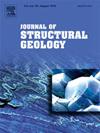Effects of backstop vertical position on the evolution of a backthrust dominated fold-and-thrust belt: Insights from viscous/brittle analogue models and comparison with cascadia
IF 2.6
2区 地球科学
Q2 GEOSCIENCES, MULTIDISCIPLINARY
引用次数: 0
Abstract
The most common features of a fold-and-thrust belt (FTB) are forward and backward thrusts, the distribution of which depends on several parameters that have been tested extensively. To further understand the development of FTBs in which an incompetent (viscous) detachment layer exists between an overlying deformed sedimentary pack (reverse faulting) and underlying undeformed basement, this study comprises four different viscous(bottom)/brittle(top) analogue models to test the effects of a new parameter, the vertical position of the piston's base relative to the viscous/brittle interface. Given that the models include a basal viscous layer, we also tested the effects of variable strain rate. The results indicate that both tested parameters significantly influence the internal structure of the sand wedge regarding wedge slope, structural style and thrust vergence. Finally, we compare the experimental results with the formation of the Cascadia FTB, and conclude that the model with shallow piston and constant piston velocity reproduces all the critical features of the composite structure of the Cascadia FTB, i.e. a foreland domain with dominant landward vergent thrusts and a shallow taper angle, a hinterland domain with dominant oceanward vergent thrusts and a flat topographic surface (taper angle = 0°), and a triangular zone separating the two domains with opposite vergences.
支撑体垂直位置对逆冲主导褶皱冲断带演化的影响:来自粘/脆模拟模型的启示及与瀑布状构造的比较
褶皱逆冲带(FTB)最常见的特征是向前和向后的逆冲,其分布取决于几个经过广泛测试的参数。为了进一步了解上覆变形沉积组(反向断裂)与下伏未变形基底之间存在不完备(粘性)滑脱层的FTBs发育情况,本研究采用了四种不同的粘性(底部)/脆性(顶部)模拟模型,以测试一个新参数的影响,即活塞基座相对于粘性/脆性界面的垂直位置。考虑到模型中包含一个基底粘性层,我们还测试了变应变率的影响。结果表明,两种试验参数对砂型楔体的内部结构均有显著影响,包括楔体坡度、构造样式和逆冲辐合度。最后,将实验结果与卡斯卡迪亚FTB的形成过程进行了对比,得出结论:活塞较浅且活塞速度恒定的模型再现了卡斯卡迪亚FTB复合结构的所有关键特征,即前陆域以向陆地的辐合冲断为主,且锥角较浅;腹地域以向海洋的辐合冲断为主,且地形平坦(锥角= 0°)。还有一个三角形的区域将两个相对的边界区域分开。
本文章由计算机程序翻译,如有差异,请以英文原文为准。
求助全文
约1分钟内获得全文
求助全文
来源期刊

Journal of Structural Geology
地学-地球科学综合
CiteScore
6.00
自引率
19.40%
发文量
192
审稿时长
15.7 weeks
期刊介绍:
The Journal of Structural Geology publishes process-oriented investigations about structural geology using appropriate combinations of analog and digital field data, seismic reflection data, satellite-derived data, geometric analysis, kinematic analysis, laboratory experiments, computer visualizations, and analogue or numerical modelling on all scales. Contributions are encouraged to draw perspectives from rheology, rock mechanics, geophysics,metamorphism, sedimentology, petroleum geology, economic geology, geodynamics, planetary geology, tectonics and neotectonics to provide a more powerful understanding of deformation processes and systems. Given the visual nature of the discipline, supplementary materials that portray the data and analysis in 3-D or quasi 3-D manners, including the use of videos, and/or graphical abstracts can significantly strengthen the impact of contributions.
 求助内容:
求助内容: 应助结果提醒方式:
应助结果提醒方式:


